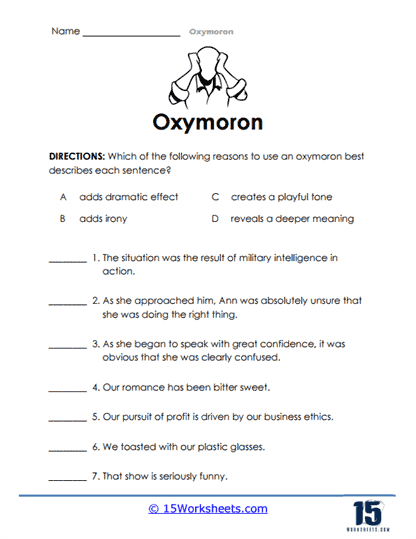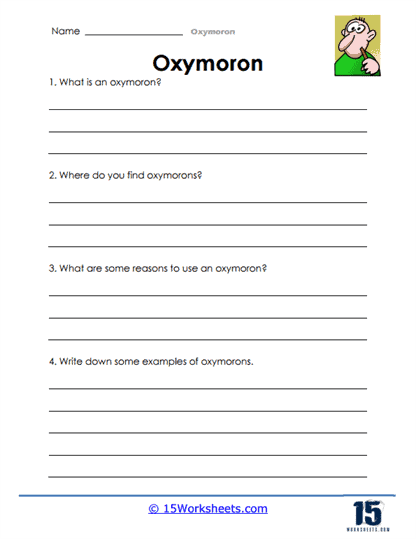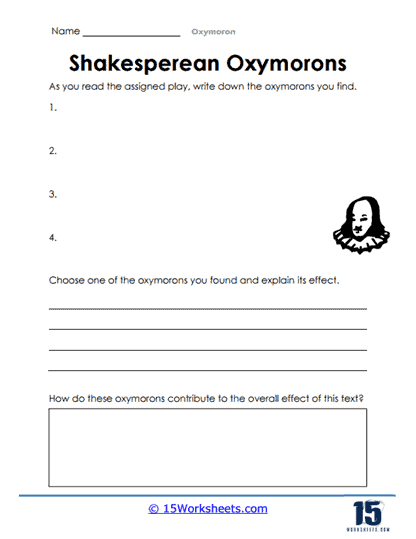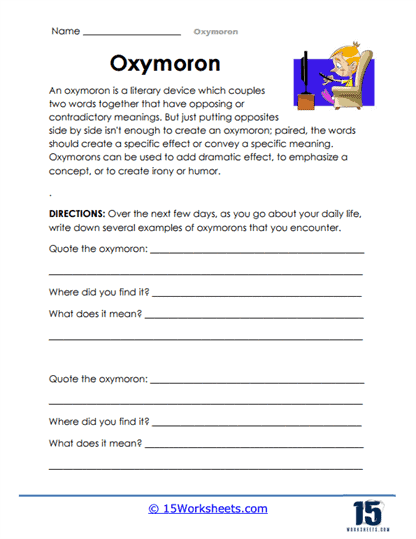Oxymoron Worksheets
About These 15 Worksheets
These worksheets help you understand and practice using oxymorons in language. An oxymoron is a figure of speech that combines two contradictory or contrasting terms side by side to create a unique effect or meaning.
To explain oxymorons, let’s look at some examples – “Jumbo shrimp,” “bittersweet,” or “living dead” are all examples of oxymorons. These phrases combine words with opposite meanings, creating a contrast that can be surprising or thought-provoking.
Oxymoron worksheets provide exercises and activities that help you recognize, identify, and create oxymorons in sentences or descriptions. These worksheets often contain examples of sentences or phrases, and you have to identify the contradictory words and understand the effect of their combination.
By working on oxymoron worksheets, you can:
Identify Oxymorons – Oxymoron worksheets help you develop the skill of recognizing oxymorons in language. By reading sentences or passages, you learn to identify phrases or expressions that combine contradictory or contrasting terms. This skill allows you to appreciate the creative and playful use of language in highlighting contrasts.
Understand Contradictory Meaning – Oxymoron worksheets allow you to explore the contradictory meanings of oxymorons. You learn how combining opposing words can create an unexpected or deeper meaning. By understanding oxymorons, you gain insight into the power of language to express complex ideas or emotions through paradoxical combinations.
Enhance Writing Skills – By learning about oxymorons, you enhance your own writing skills. Oxymorons provide a tool to make your writing more expressive and thought-provoking. By practicing oxymorons through worksheets, you develop the ability to incorporate these figures of speech into your own writing, adding layers of meaning and engaging your readers.
Encourage Critical Thinking – Oxymorons encourage critical thinking and creativity. By combining contradictory terms, oxymorons challenge conventional thinking and invite readers to question assumptions or explore paradoxes. Working on oxymoron worksheets fosters a mindset of critical thinking and encourages you to consider alternative perspectives.
Appreciate Language Play – Oxymoron worksheets foster an appreciation for the creative use of language. Oxymorons demonstrate the inventiveness and versatility of language in capturing complex ideas or emotions. By exploring oxymorons, you develop a deeper understanding and appreciation for the beauty and artistry of words.
Why Do Authors Use Oxymorons In Their Work?
Authors use oxymorons in their work for several reasons:
Evoking Contrasts – Oxymorons allow authors to highlight and emphasize contrasting ideas or concepts. By combining contradictory words, they create a tension that draws attention to the contrast between opposing elements. Oxymorons can be used to convey complexity, irony, or paradox, enhancing the depth and meaning of the text.
Adding Literary Flair – Oxymorons add a touch of literary flair and creativity to the writing. They catch the reader’s attention and make the language more engaging and memorable. By using unexpected combinations of words, authors can create a unique and distinctive style that stands out in the reader’s mind.
Creating Visual or Sensory Effects – Oxymorons can create visual or sensory effects by juxtaposing words with contrasting attributes. For example, “dark light” or “deafening silence” evoke vivid mental images or sensations. These paradoxical combinations enhance the reader’s experience by engaging multiple senses and adding richness to the descriptions.
Enhancing Emotional Impact – Oxymorons can intensify the emotional impact of the writing by capturing complex or contradictory emotions. They express emotional nuances that may be difficult to convey using straightforward language. The contrast between opposing terms can evoke a sense of ambiguity, tension, or heightened emotional depth.
Conveying Paradoxical Ideas – Oxymorons are useful for conveying paradoxical ideas or exploring philosophical concepts. They allow authors to address contradictory aspects of human nature or the complexities of existence. Oxymorons can invite readers to reflect on the contradictions and ambiguities of life, encouraging deeper contemplation and discussion.
Providing a Stylistic Device – Authors may use oxymorons as a stylistic device to create a specific tone or mood. By deliberately incorporating these contradictory phrases, they can establish a particular atmosphere, such as a sense of irony, mystery, or absurdity. Oxymorons contribute to the overall aesthetic quality of the writing, adding depth and sophistication.















